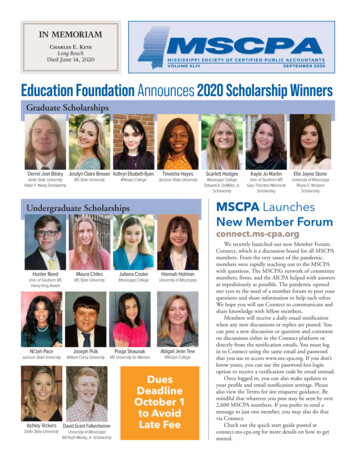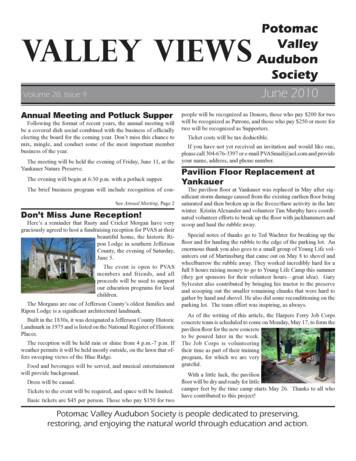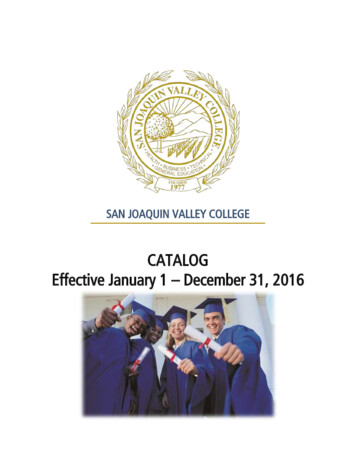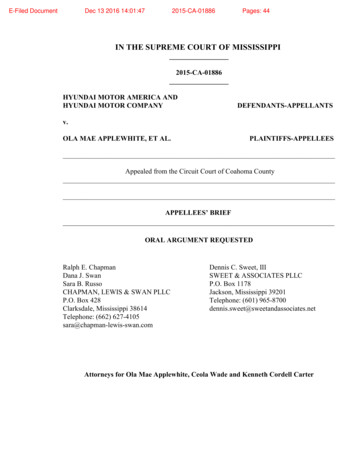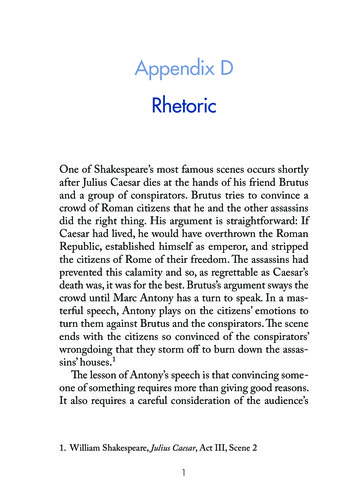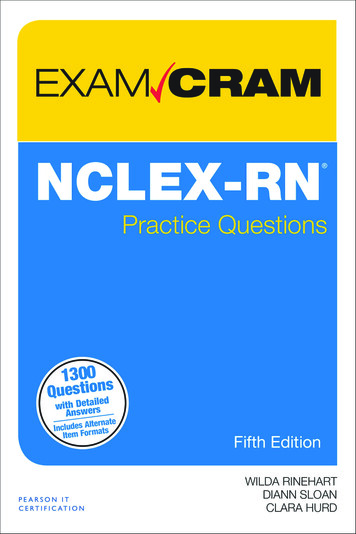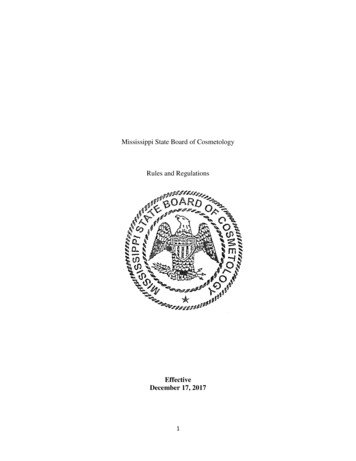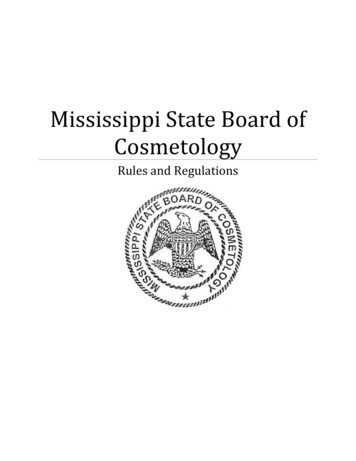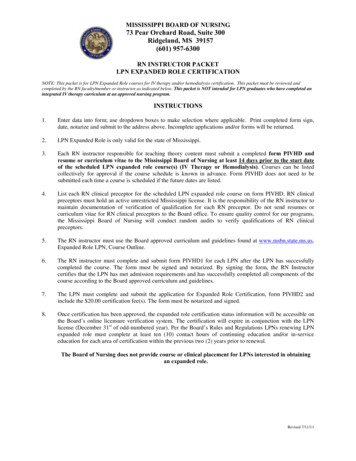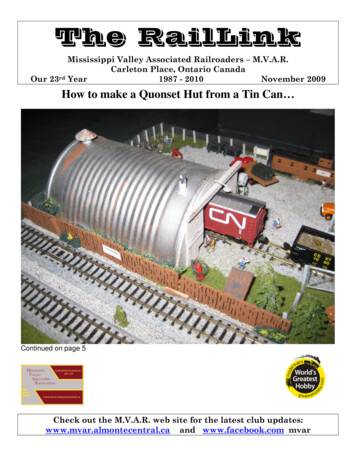
Transcription
The RailLinkMississippi Valley Associated Railroaders – M.V.A.R.Carleton Place, Ontario CanadaOur 23rd Year1987 - 2010November 2009How to make a Quonset Hut from a Tin Can Continued on page 5Check out the M.V.A.R. web site for the latest club updates:www.mvar.almontecentral.ca and www.facebook.com mvar
The Presidents Message for November 2009.By Eric HalpinWell we survived the first MVAR meeting at the Carleton Place Library. Aswith any new venue there were a few minor hiccups but overall I thoughtthings went very well. It certainly is a nice place and a bit more central formany guys, so hopefully we shall see a greater attendance in coming monthsespecially in the winter. I want to thank all who were involved in arrangingthis change but especially David McCurdy and Larry Skinner. I counted 29fellas out at this meeting and several new members. The ‘show and tell’worked well; the program on turn-outs was very good and I especiallyenjoyed how three members all made their turnouts using slightly different methodology eachwith satisfactory results. Please be aware that it is perfectly okay for you to bring out anythingyou have to sell or trade with other members at the meeting.Speaking of coffee as the new fund manager, I can report that we made just enough to coversupplies ( 3 profit selling at 1). We did run out of coffee, so maybe I will have to prepare twourns and charge 2 for unlimited refills versus 1 a cup?I want to welcome David Biggs to the executive as the ’At Large’ rep and librarian. David willserve the club and executive in general, as a consultant and source point of reference on any andall issues. Your executive had a meeting at Larry Skinners house on Oct 14 to discuss manyinitiatives and ideas which are all to aid YOU the member. Thanks again to Larry and othersfor putting this meeting together.HAVE YOU RENEWED YOUR MEMBERSHIP FOR 09-10 SEASON?Please don’t delay in doing this.Check out some of the new links on our web site. There are some very informative sites withterrific info in them.Your executive can only provide so much energy into running the club for you. We need helpto keep things going. David McCurdy can always use articles on anything railroad (real ormodeled) plus pictures with story lines, etc; Mike Smithson needs help in getting speakers andclinics going. This means maybe YOU can give a talk on some topic or help perform a clinic.Larry needs people to spread the word about the hobby and the club. Please take some of thenew MVAR flyers and spread them around town at various community bulletin boards.There are scads of train shows this time of year. I sure hope you are trying to attend some ofthese.Railfair was a great success again this year. In case you don’t know, most proceeds go tosupport the CHEO hospital. There were some real deals to be had at the show as an example:Badger air brushes normally 120 for 25; several Cornerstone structure kits regular 85 for 35; flex track for 1.35 each instead of 4.00 and up; Peco turnouts for 20 versus 35 each.2
I also saw some DDC locos with sound for as low as 85! Sometimes the stock of somevendors gets a bit stall as one fella I know has been carrying around the same two ONR locosfor at least three years. The modular layouts were as usual great both in HO and N. TheLindsay Model Railway club even brought their modular layout. I always find few new ideasand concepts from seeing these layouts. I was also happy to see a few of you at the show also.Member John Soehner returned recently from a western USA rail fan and photo trip. Hopefullyhe will give us an update article on some of the great sites and trains he saw. I didn’t read abouthim in the newspaper or see him on CNN, so it is fair to presume he behaved himself.If any of you members have any ideas about what the club should/could do for the 25 thanniversary, please call or send me a note. It is not too early to discuss these ideas and one ideain particular is now in front of your executive. So don’t be left out in the cold with yourideas. Let me know.Eric HalpinThe Great New York State Model Train Fair – Syracuse, NY – Nov 7, 2009Early Saturday morning (7 Nov 09) Andrew Shinn, Bob Carswell, Jack Leonard and I bundledinto Jack’s car and set out for Syracuse, New York – our destination The Great New York StateModel Train Fair – and great it was! Saturday was a balmy sunny day, with shirtsleeve weatherand the three-hour drive and the twenty-minute line-up to enter the show was soon behind us.Once inside our true railroader nature kicked in and we literally lost ourselves in the sights.There were many different displays with some wonderful modeling showing off a number ofgauges ranging from N to 7¼, some with scratch built scale rolling stock, structures, dioramasand modular layouts. There was a large contingent of miniature circus displays, again in anumber of different scales and among the toy trains vintage Lionel tinplate, modern Williamshi-rail scale. There was even a layout with vintage American Flyer S scale with mechanicalsound and smoke on board the locomotives driven by miniature piston pumps – these were asbuilt out of the box circa 1955!The fair, celebrating its 35th year, had 294 exhibiters listed in its two huge buildings. There waseven a real 12” to the foot excursion run via the Finger Lakes Scenic Railway running fromSolvay to Martisco NY.This fair was well worth our trip. We all picked up some real bargains, had a great timetogether, and I gave the fair about 8 out of 10 – definitely a keeper in my books. You can have alook at the website at http://www.modeltrainfair.comLarry Skinner3
The Treasures Report – As of the end of October 2009By Ben SandersThe opening balance with cash on hand as of October is .This year‟s dues are 10. The New Membership List will be given out at theNovember meeting. The MVAR hats are sold out.bsanders@ucalgary.ca.Public RelationsBy Larry SkinnerOn Thursday November 26, will be our second meeting at the new location theCarleton Place Public Library. Doors open at 6:00pm and meeting start at6:30pm.The Topic is “SO YOU WANT TO BUILD A RAILROAD” continued.WANTED - Model Railroad Articles for the RailLink.By David McCurdyPlease remember that this is YOUR club and if YOU want to make itexciting and active it is up to YOU to do so. If YOU have an article or photoof interest which you would like to share and have published, just email them todmccurdy@sympatico.ca. The deadline for submission of items for The RailLinkis by the 15th of each month. Thanks' to all who have contributed articles, itemsand photos in the past.WebmasterBy Rod Goodwin For all those who have web pages, you may post a link on our website.4
How to make a Quonset Hut from a tin canOr how to get your wife to make a Chick Pea SaladBy Bob CarswellBack in July, my wife told me to get a hobby.Always fascinated by model train layouts, and knowing that Jack Leonard had a“modular” layout that he occasionally displayed, I immediately went off to talk tohim. He introduced me to the T-Track Modular Layouts site at http://www.ttrak.org/index.html and The Unofficial T-Trak Handbook site at http://ttrak.cincy.home.insightbb.com/ and I was on my way to Home Depot forStyrofoam.Once I had my first module cut out, glued down and ready for track, I was stuckwith the dilemma of what to do with it. Somewhere along the line I rememberedbeing told once, model what you know. Well, I am a prairie boy, grew up in southern Manitoba, so Ifigured I could do small town Manitoba, a farm, my dad‟s business, that sort of thing. But, I had seenthis salvage yard once. Maybe I could do that. I could picture it in my mind‟s eye.A Quonset hut;big enough tobring a rail car infor disassembly.A caboose foran office.Piles of “truck”parts,wheels,ties.Why not?A quick trip toHobby House,thenalookonline convincedme that therewas no Quonsethut kit that wouldbe big enough toaccommodate arail car, whichwould also needrails to take the car inside. So what to do? Then I hit upon the idea of using a soup can.Well, that resulted in a lunch of Tomato Soup, but when I cut the can in half it was too small. Next Itried a can of brown beans. Good thing I spent years in the forces having warm beans with my eggsfor breakfast – the brown bean can was also too small.Another thing I was beginning to realize by this point, neither the soup can nor the bean can were“ribbed” like corrugated metal. So there I was in my wife‟s panty feeling cans through their labels.5
I found it. A can of chickpeas. Through the label, thetexture felt about right,looked to have about theright diameter so that whencut in half it would standproud enough to allow a railcar inside. It also offeredone other thing I felt wasimportant – unlike thetomato soup can, you couldremove both ends neatlywith a can opener. I was offand running.Once I had both endsremoved, it was fairly simpleto cut the can in half withmetal cutters, then,Imanufactured front and rear“walls” from balsa wood.The front piece had to be cut to accommodate “sliding doors”. Now I was faced with another problem.First I tried gluing the rear wall to the can with Testers Model glue; didn‟t hold, next I tried Welbond,didn‟t work. Third try – success. Tester‟s Wood and Metal Model Glue (green tube) worked.Word of caution here for anyone who tries this. When you cut both ends out of a can, then cut the canin half, it goes squint, and the more you try to bend it to shape, the worse it gets. Solution: peg it inplace. I used 2 inch finishing nails into a piece of pine to hold the can while glue for the end piecesdried in place.While all of this was going on, I started working on the Quonset hut floor. First I laid out a piece trackbed and Atlas flex track (about one inch longer than the Quonset hut). Once that was in place I thenblocked off the outside dimensions of the can (Quonset hut) with pieces of Popsicle sticks and tackedthem into place with straight pins into the Styrofoam for my module. With the “frame” in place aroundthe track bed and track, I then put down the „concrete” floor using ready mix plaster. Once it was dry,and after a little sanding I had my concrete floor.Before fixing the Quonset hut in place I spray painted the interior with flat white, and the exterior withsilver. Mounting the “sliding” doors to the front was tricky – the track bed and track outside the hutwas higher than ground level, so they had to be cut to allow for that. A metal chimney was cut from ajuice box straw, and the air vent was hand made from an old business card.So, by now you‟re asking: “What about the chick pea salad?”Well, when your better half finds the chick peas in the bowl you left in the fridge after dumpingthem out of the can, you can simply say that you put them there hoping that she would make herfamous chick pea salad. That almost worked.6
Attention to DetailsBy John SoehnerI must say every time I visit Eric Halpin‟s Algoma and Rideau Layout, there‟salways something new to view in terms of the finer details and scenes he hascreated!Theboardinghouse scene nearthe Perth Stationhasinterestingfeatures such asthe fencing, theouthouse to the leftand stairs to thetracks and station.The only thingmissing is a cloth‟sline with someStanfields airing inthe breeze!The loading dock near theMeat Processing plant hassome great detailing with thegarbage pails, the small shedand the weeds around thedock area.7
Check out the crossing with the wood planking, and the work crew digging up the fresh pavement.Just like what happens in Perth or Smiths Falls when repairs are made, the works department createsmore potholes!AroundtheSteamService area, the boysearly in the morningawait instructions fromthe foreman. Lots oftools, hardware andmaterial, piles of gravel,sand,ballastingmaterial for any jobsthat will be assigned.8
Barrels, pallets, junk atthe back of the buildingadd to the scene.I‟m not sure if Eric will ever get this building finished next to the Whistle stop Station!?! The detailingis great and a good story could be made to describe what is happening, or not happening at theconstruction site!9
BehindtheHosegood Hosesplant, a smallforklift has a palletof material to belifted onto theyellow IH truckwhile the WhiteCPRtandemtakes the load ofpennies from themint to the nearbyrailway station.On my own Whitby, Westport and Port Railway an attempt has been made to scenic several areas.The Steam Era required all kinds of hostlers, maintenance workers and general labourer for much ofthe day to day operations. As such in many of my scenes there are “gangs” of workers to completethe various tasks. Around the ashpits there are numerous workers with long rakes to clean out theashpans, a heavy duty water hose to quench the hot ashes and cinders and for keeping the ashpitarea in reasonable tidy shape.Detailing though somewhat tedious can be interesting and make for some great looking scenes!Does the story make the scene or does the scene make a story?10
ABOUT THE CABOOSEBy David McCurdyThe 78185 caboose wasbuilt in 1929 in the CNRTranscona Car Shops.This is a typical CNRcaboose complete withbeds, coal bin, sink,water tank, desks, stove, oven, ice-block refrigerator and cupola seats with backs that flip to facethe direction in which the train is running.It was restored to its original condition in the winter of 1987-1988 and received a new coat of paintin the summer of 1996. It was used in the filming of "Monte Walsh" starring Tom Selleck and wasrepainted for the movie. New paint and re-stenciling will take place next season.The caboose had many nicknames among railway workers: crummy, cab, van, doghouse, hayrack,waycar, conductor's van, and even "brain box" or "brains box". Modern CNR employees call it thecab or caboose while CPR employees call it the van as do CN eastern lines employees.The caboose is the conductor's home and office. The conductor is responsible for the entire trainand train crew, except the locomotive. The conductor and engineer work together to keep thetrain on schedule. The conductor must know exactly who and what is on his train, how many tons,the origin and destination of each item or passenger, etc.The conductor is assisted by one or two brakemen (or trainmen as they are known on passengertrains). They throw switches, couple and uncouple cars, check brakes and make sure the train runssafely. The head end brakeman rides in the locomotive cab and the tail end brakeman or "brakie"rides in the caboose with the conductor. In the days before the installation of air brakes, brakemenhad to climb on the roof of the train to manually set and release the brakes.The conductor and the brakeman ride in the cupola, which is the raised portion on the roof of thecaboose or on its side. They look down the length of the train to see or smell "hot boxes":overheated axle bearings that could catch fire or seize up and cause a derailment. They also lookfor dragging equipment, shifted loads, fires, loose straps, or hoboes. If anything out of the ordinaryis detected, the conductor signals a stop with his lantern or pulls the emergency brake. Theproblem is fixed by the train crew or the car is set out on a siding to be repaired later.11
As the train travels, the station agents alongthe line receive new orders for the train bytelegraph. The train order board is displayedto the approaching train, telling the train crewto pick up orders. Train orders are copied andput in a metal bracket on a wooden hoop.These orders are passed to the locomotivecrew and caboose crew using this hoop. Theorders are read and reread and then carriedout by the crew, since each end of the trainreceived the same orders.12
At the end of a day's work, the caboose was taken off the train and set out on a siding. The crewwould eat and sleep in it overnight and be put on another train the next day.During the early days of railroading, conductors and brakemen saw the caboose as their home awayfrom home. Each crew would often bring personal belongings from home. Conductors made theirown symbol to put on the roof of their caboose to help them find their "home" in a crowded railyard. At the end of a day's work, the caboose was taken off the train and set out on a siding. Thecrew would eat and sleep in it overnight and be put on another train the next day.Each caboose came with three benches with mattresses stored underneath, a coal bin, a stove forheating and cooking, a sink, water for drinking and washing, a conductor's desk, and an ice blockrefrigerator. The caboose also had a first-aid kit, stretcher, switchman's hand lanterns, and aflag/flare kit. Newer cabooses have no beds, but do have an electric refrigerator, heaters, anoven, a toilet, lockers, an eating table, and a conductor's desk.Eventually, the caboose was phased out. In February, 1988, the Canadian Transport Commissiongave permission to Canadian railways to replace the caboose with the new end-of-train unit. Theconductor moved into the locomotive cab with the engineman and front-end brakeman. By the fallof 1988, CNR and CPR began the removal of the caboose from active duty. Trains are now operatedby a conductor and locomotive engineer both located in the cab of the locomotive.This article was taken from The Alberta Railway Museum web site, located in Edmonton, Alberta, CA.13
CPR Station at Ottawa West in 1963 with the eastbound Canadian getting train orders.The Devils ClimbIt has been my pleasure to be able to assist and hopefully help several model railroaders with their layouts overthe past several years. This past week was another opportunity, when friend Larry Skinner called for assistancewith a few issues in his hidden yard throat as well as establishing the sub-roadbed grade from the hidden stagingto the main level. Please refer to the MVAR web link to members layouts.’The Ontario and North Eastern’(ONE).The yard throat situation was resolved quickly with some minor tweaking of Larry’s handmade ‘FastTracs’.They are nice turn-outs and he has done a good job of building them. The real task that lay ahead for us wasbuilding the curved, serpentine grade from the aforementioned hidden staging yard up to the main yard via atrack around Jefferson Flats. This track is approximately thirty linear feet in length and must rise by seven andone half inches. Before the fun starts, let’s talk grades.Model railways, just like the prototype usually avoid grades where practical as the effort to climb is difficultsince you are fighting gravity. Grades on curves further complicate things because wheel friction against therail sides increases drag. On a model railway, all this climbing and side friction causes wheel slippage on theengine and can even result in stalled engines. On a curved grade that is also serpentine (‘S’ shaped) the dragcan sometimes be so significant that side forces try and pull the train straight, sometimes right off the track midtrain. Often, modelers overcome this situation by running shorter trains then they would normally prefer.14
There are other partial solutions to the grade situation also. One concept is to have some level trackage in thegrade track to allow the engine a chance to regain speed. The problem with that solution is that in a given fixeddistance that you have to work with on the layout, the rest of the grade track must be additionally increased tomake up for the elevation you lost on the level track.A better concept is to continue to increase the grade at a uniform value but try and insert some straight track(not level but straight) along the climb. Straight track also serves the purpose of allowing the couplers to realign themselves before entering the next opposite curve.But modelers love grades and most put them on their layouts when they have the space. Why youask .because it presents drama on a layout! On the A&R I sometimes need a MU’d engine set to haul atrain up Algoma Mountain or even a tail end pusher when the steamers are running. Grades make the operationof your trains a bit more difficult but no less fun. But, I digress.Now I said earlier that the grade in question on the ONE was about thirty linear feet (360”). A 1” rise in 100” isequal to a 1% grade. So a 3.5” rise in 350” is also a 1% grade. But on the ONE, we had to rise 7.5” which istherefore a bit more than a 2% grade. Now this type of grade can be a challenge especially with light engines.But we are now dealing with not only a grade but also with curves and a serpentine track. Larry’s correctsolution was to incorporate two sections of straight track on the climb. This should help the engines andcouplers somewhat.But how do you build such a long graded track? For most modelers, nothing beats the human eye atdetermining imperfections in the grade. Both Larry and I could readily see even a 1/8” deflection from theconstant grade when viewed from a remote corner of the train room. So remember to trust your eyes. Also,you need lots of patience when tackling this sort of trackage as it takes a lot of time to achieve the constantgrade you require. Did I mention you also need lots of clamps to temporarily hold the joist risers?On Larry’s layout, we completed, what I think, will be the most difficult part of his construction. I don’t knowwhat Larry is going to call this section of track but I am suggesting it will acquire a name (or two) when thetrains start rolling. But hey, the opportunity of running a train on challenging track should be lots of fun andthat’s what this game is about FUN.Eric HalpinSome of the M.V.A.R. members Railway Patches.Dennis MacTavishEric HalpinDavid BiggsJohn SoehnerJim DavisDavid McCurdyBob Summers15
Coming EventsNovember 26 - M.V.A.R. Meeting at the Carleton Place Public Library.Thursday – Doors open @ 6:00pm, Meeting @ 6:30pmProgram: So You Want To Build a Railroad - ContinuedSpeaker:Christmas breakfast at the Gourmet Saturday December 19th @ 07:30hThere is no monthly meeting in December.January 28 - M.V.A.R. Roast Beef Dinner & Meeting at Christ Church AshtonThursday – Doors open @ 6:00pm, Dinner @ 6:30pmProgram: “All about the Bytown Railway Society”Speaker: David StremesFebruary 28 O.V.A.R. Model Train Flea MarketSt Anthony’s Hall – 523 St. Anthony St, OttawaSaturday 10:00 – 14:00March 26 - M.V.A.R. Meeting at the Carleton Place Public Library.Thursday – Doors open @ 6:00pm, Meeting @ 6:30pmProgram: So You Want To Build a Railroad - ContinuedSpeaker:April 22 - M.V.A.R. Roast Beef Dinner & Meeting at Christ Church AshtonThursday – Doors open @ 6:00pm, Dinner @ 6:30pmProgram: “ To Be Announced”Speaker:For more shows check the Ontario Model Train Shows Calendar on our website.MVAR Executives for The 2009-2010 Year.President:Eric Halpin613.264.9693Secretary/Archivist Ron Legge613.257.5110Treasurer:Ben Sanders613.253.6064Membership:David McCurdy613.253.5519Program:Mike Smithson613.253.7532Public Relations:Larry Skinner613.264.0081Library:David Biggs613.863.7627Newsletter:David McCurdy613.253.5519Webmaster:Rod Goodwin613.256.0551Web Site:www.mvar.almontecentral.caCheck out the M.V.A.R. web site for the latest club updates:www.mvar.almontecentral.ca and www.facebook.com mvar16
The RailLink Mississippi Valley Associated Railroaders - M.V.A.R. Carleton Place, Ontario Canada Our 23rd Year 1987 - 2010 November 2009 How to make a Quonset Hut from a Tin Can Continued on page 5
